Misc Behaviours
A collection of small, general / single purpose built behaviours
Movement / Tracking
Universal Tracker
Tracks the local player's Tracking Data source, or a Bone transform and copies it over to the target transform
Parameters
Track Bone: Switches between tracking a Tracking Data source (Head/Hands) and tracking Bones
Bone: Only visible when Track Bone is checked. Specifies which Bone to track
Track Player Base: Switches to player base tracking mode where the Target Transform will follow the player's ground position
Track Playspace: Switches to playspace tracking mode. Allows Target Transform to persist in players playspace, only moving when the player moves with the stick
Tracking Target: Only visible when Track Bone is unchecked. Specifies which Tracking Data target to use
Target Transform: Transform to copy the tracked Bone / Tracking Data position and rotation to
Track Position: Specifies whether the position should be copied
Track Rotation: Specifies whether the rotation should be copied
Tracking Correction: Allows to apply an extra X/Y/Z rotation to the transform after copying it over
Follow Main Camera: For editor use only. Makes the object follow the main camera, helpful for editor testing
Events
Reset Offsets: Resets the player offsets from their player base tracker. Call this to calibrate player offsets at least once, otherwise the tracking will be wrong
Usage / Examples
The basic usage of this component is intended to be things like attaching objects to player's hands, head or both.
Lerped Follower
Makes an object follow another object with smooth interpolation
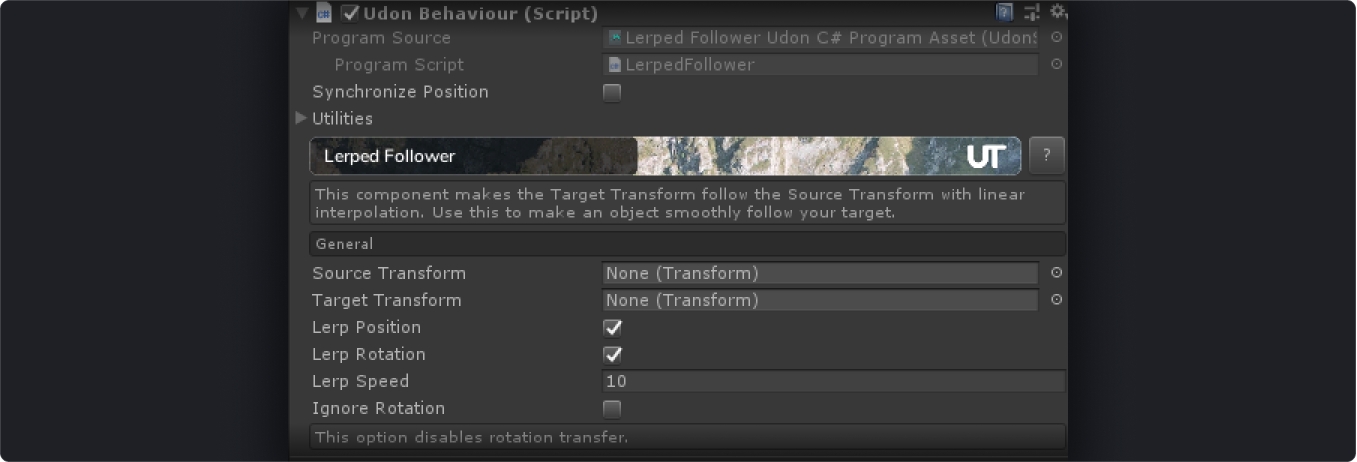
Parameters
Source Transform: The source of position and rotation to copy from
Target Transform: The target of position and rotation to copy to
Lerp Position: Specifies whether the position should be interpolated (smoothed) or instant
Lerp Rotation: Specifies whether the rotation should be interpolated (smoothed) or instant
Lerp Speed: A speed with which Target will achieve Source's position and rotation
Ignore Rotation: Specifies whether to copy rotation or completely ignore it
Usage / Examples
Generally good feeling lerp value for scene objects seems to be at around 5-15, for the player attached object (like with Universal Tracker) higher values are recommended.
Ignore rotation can be used in cases where you want to have the object look at a particular spot or generally not rotate with the Source object. Thins like Rotation / LookAt or Aim constraints come to mind as good combinations.
Triggers / Actions
Universal Action
The bread and butter of any world reactivity, allows you to perform various actions in response to an incoming Trigger event. Think about it as a VRC SDK2 Triggers Lite
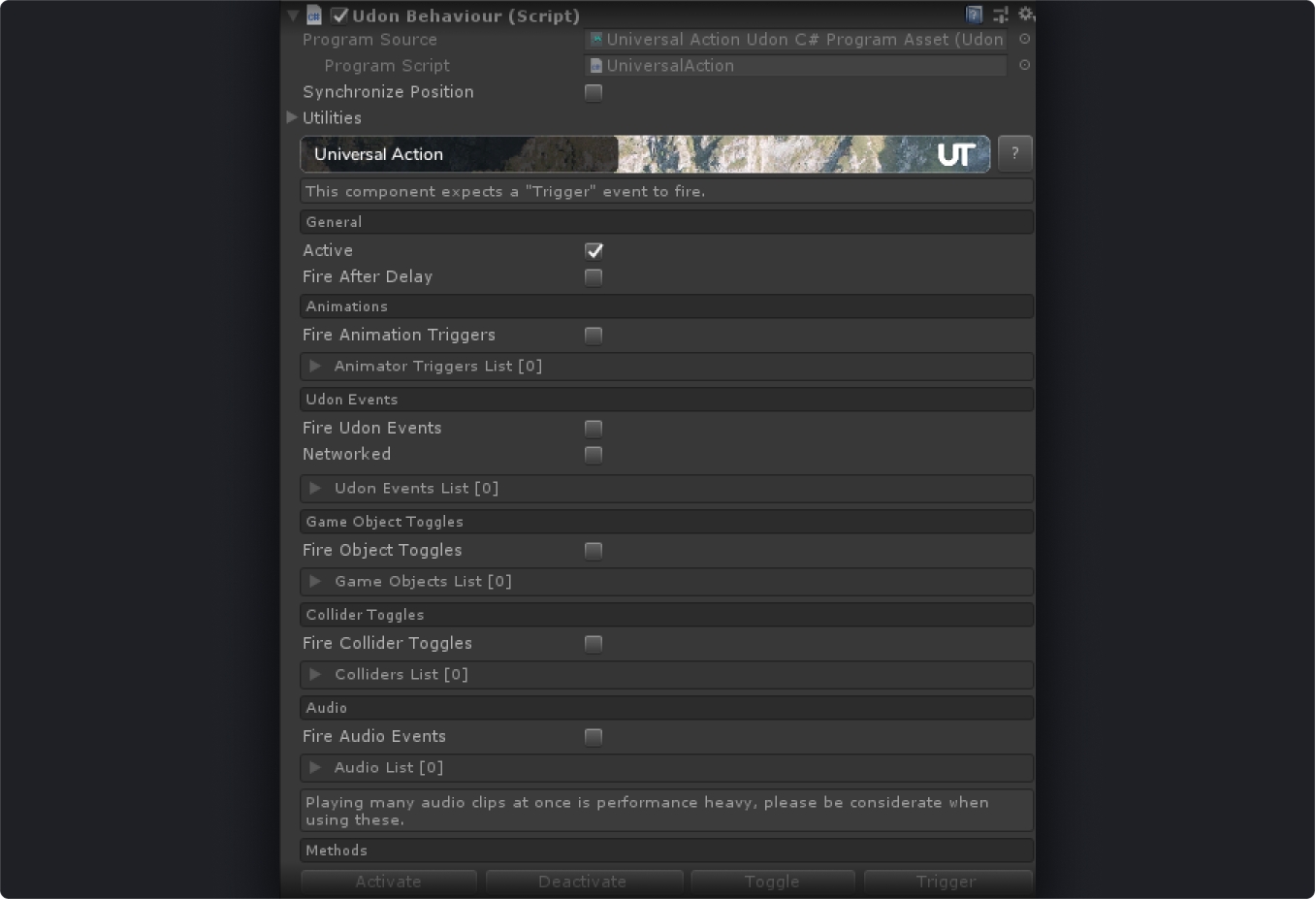
Parameters
Active: Determines if the behaviour is running, since toggling game objects on and off only means they won't run
UpdateFire After Delay: Object must be enabled at all times for this to work. Specifies whether the triggers should be fired after a delay
Delay Length: Only visible when Fire After Delay is checked. Sets the delay length in seconds
Fire Animation Triggers: Specifies whether the Animation Triggers should be executed
Animator Triggers List: A list of Animators and Triggers to fire, you can specify the same Animator multiple times to fire multiple triggers
Fire Udon Events: Specifies whether the Udon Events should be sent
Networked: When checked - Udon Events will be sent to targets set in Network Targets
Network Target: Specifies who to send the network events to
Udon Events List: A list of Udon Behaviours and Events to call
Fire Object Toggles: Specifies whether to Enable/Disable/Toggle objects from the Game Objects List
Game Objects List: A list of Game Objects to Enable, Disable or Toggle
Fire Collider Toggles: Specifies whether to Enable/Disable/Toggle the colliders from the Colliders List
Colliders List: A list of Colliders to Enable, Disable or Toggle
Fire Audio Events: Specifies whether to Play the sound clips provided in the Audio List
Audio List: A list of Audio Sources and Audio Clips to play through them
Make sure to only use Networked option when executing this trigger locally, e.g. via a UI Button, otherwise you might cause oversync
Events
Trigger: Triggers this Universal Action
Activate: Activates the behaviour, so it will react to Trigger events
Deactivate: Deactivates the behaviour, so it will no longer react
Toggle: Toggles the active state, provided for convenience
Usage / Examples
Universal Action will probably be the most used behaviour in your world, as its basically a simplified trigger from SDK2. It is not as deep as the original triggers, though, so you are expected to combine it with more specific behaviours from Udon Toolkit or other places to extend its functionality.
This component makes it pretty trivial to do things via UI Buttons simply by calling a SendCustomEvent on it with Trigger as the event name.
You can check out a guide on setting up a basic mirror right here which should provide a good example of Universal Action usage.
The major thing to note here is to make sure that the component, and the game object its on is always enabled if you're using the Delay parameter, otherwise it will never fire as the Update method will never be called.
Secret Actions
Sends events to udon behaviours based on the player's name
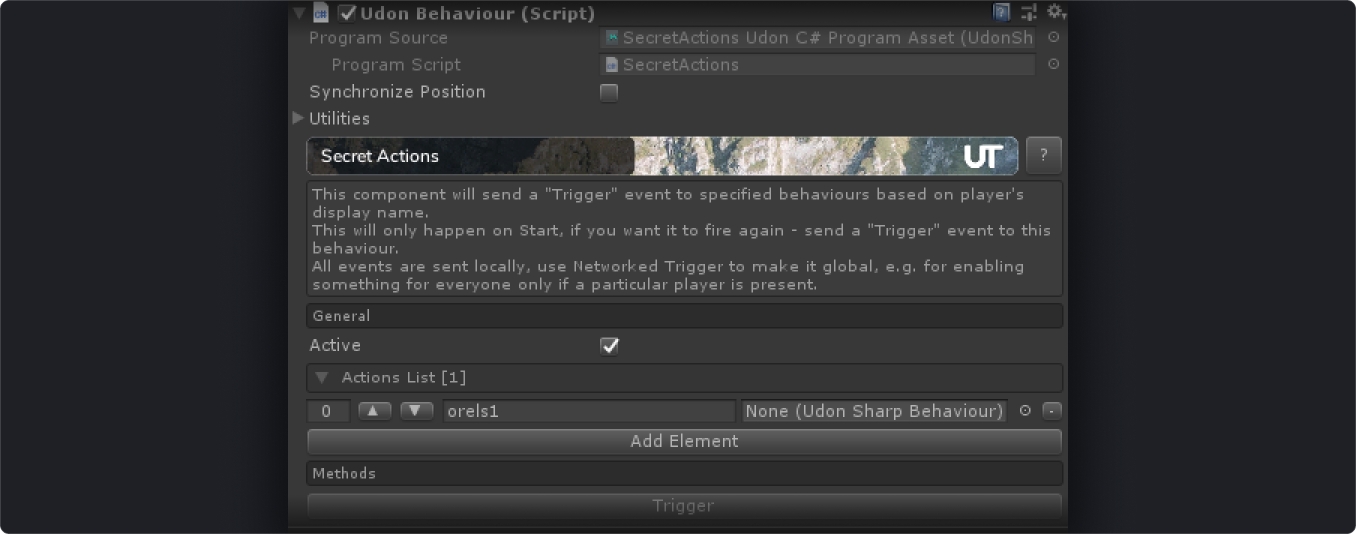
Parameters
Active: Determines if the actions will be executed on Start
Actions List: A list of Player Names and Udon Behaviours to send
Triggerevents to
Events
Trigger: Executes the logic again, you will probably want this to be called from the network to run for everyone again
Usage / Examples
Ever wanted to have something special activate only for particular users? This behaviour does exactly that! Combine this with Universal Action to do something special for that user, or specify behaviours of your own.
Make sure whatever you're trying to send an event to actually expects the Trigger event. Most of Udon Toolkit will work with this.
If sending events once isn't enough - you can use the Trigger event to fire it again.
Networked Trigger
A "proxy" of sorts that expects a "Trigger" event and sends Networked events to specified behaviours
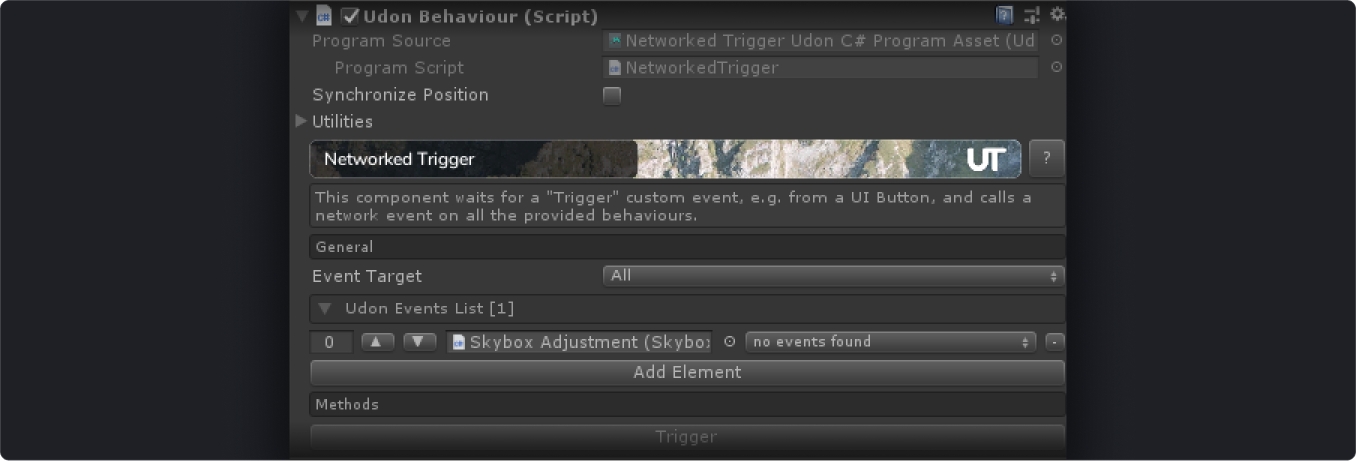
Parameters
Event Target: Specifies who to send the events to
Udon Events List: A list of Udon Behaviours and Events to send to them
Methods
Trigger: Fires the events on the provided behaviour over the network
Usage / Examples
Think about this as a middle-man between local only things and the network. While its not that useful on its own - it might serve as a nice layer between UI Buttons, and some other behaviours, that you want to call for everyone in the room, or their owners.
Area Trigger
Sends events to other behaviours when an object enters and exits a trigger collider
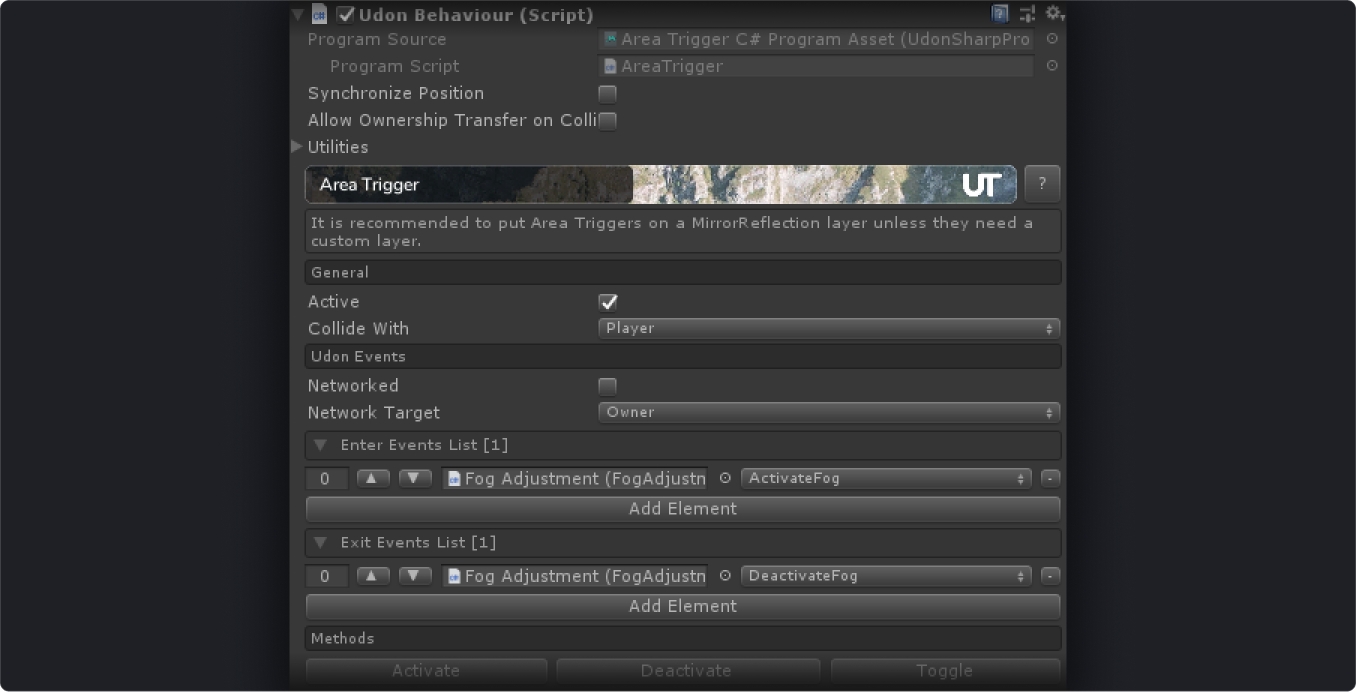
Parameters
Active: Specifies whether the triggers will fire, as just disabling the object doesn't stop it from reacting to enter/exit events
Collide With: Specifies the list of layers to filter out the objects you don't want to react to
Collide With Local Players: Specifies whether the event would fire on local player collisions
Collide With Remote Players: Specifies whether the event would fire on remote player collisions
Networked: Specifies whether the events should be sent over the network or only fired locally
Network Target: Specifies who to send the network events to
Enter Events List: A list of Udon Behaviours and Events to send when the correct object enters the trigger collider
Exit Events List: A list of Udon Behaviours and Events to send when the correct object exits the trigger collider
Events
Activate: Activates the behaviour, so it will react to objects
Deactivate: Deactivates the behaviour, so it will no longer react
Toggle: Toggles the active state, provided for convenience
Usage / Examples
This is an equivalent of VRC SDK2's Trigger Enter and Trigger Exit triggers
Some things to note when using Area Triggers
Do not use the
LocalPlayerorPlayerlayers in theCollide Withoption, use theCollide With Local PlayersandCollide With Remote Playerscheckboxes insteadGenerally speaking you would want the
Area Triggerto be on theMirrorReflectionlayer to avoid some weird vrchat issues, unless you have a case where you need a custom layerDo not use the
Networkedoption if you are usingCollide With Remote Players, as this will make everyone send events to everyone all the time, causing oversync and possibly desyncing people in the instance.
Interact Trigger
Makes something react to player interaction, VRC SDK2-style
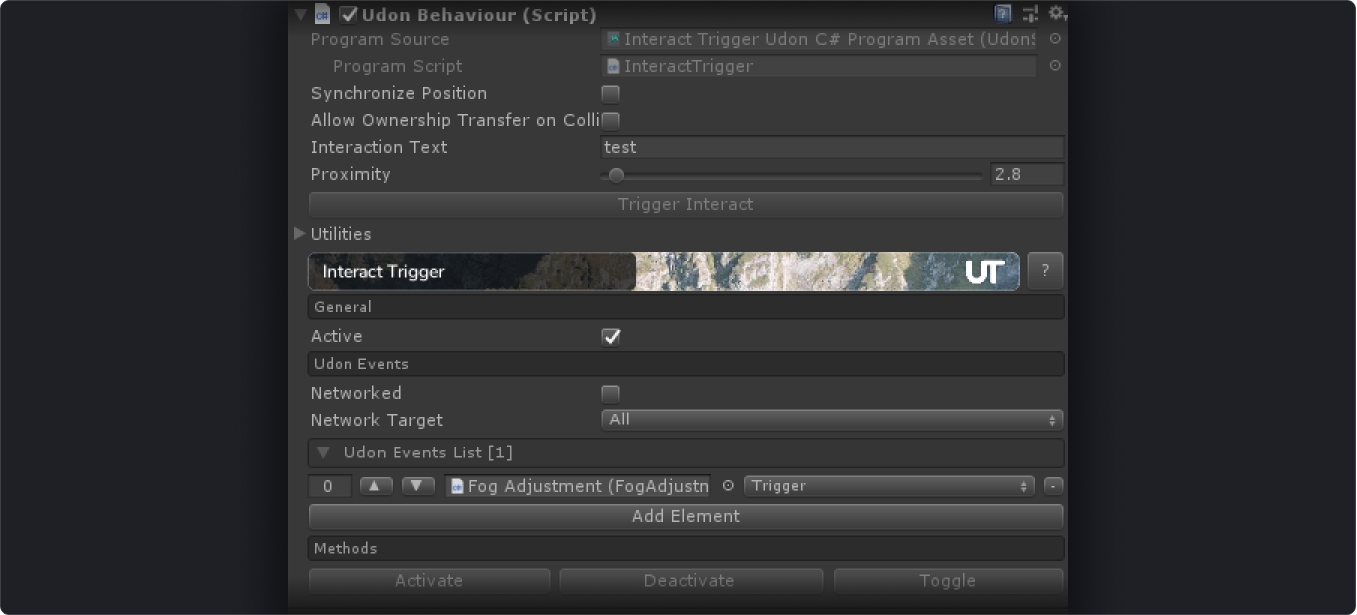
Parameters
Active: Specifies whether the object can be interacted with
Interaction Text: Sets the text shown when hovering over the object
Proximity: Sets the interaction distance of the object
Networked: Specifies whether the Udon Events should be sent to other players
Network Target: Specifies who to send the Udon Events to
Udon Events: A list of Udon Behaviours and Events to send
Methods
Interact: Sends events to provided Udon Behaviours
Activate: Activates the behaviour, so the object will become interactive
Deactivate: Deactivates the behaviour, so the object will no longer be interactive
Toggle: Toggles the active state, provided for convenience
Usage / Examples
This is an almost one-to-one equivalent of the VRC SDK2 Interact trigger. Use in combination with Universal Action to do something when user clicks on an object.
Activate/Deactivate/Toggle events will also allow you to disable the highlight on the object, if you don't want it to be interactive anymore.
Object Boundary Trigger
Sends Events to Udon Behaviours if a target object crosses a particular threshold and disables itself (by default)
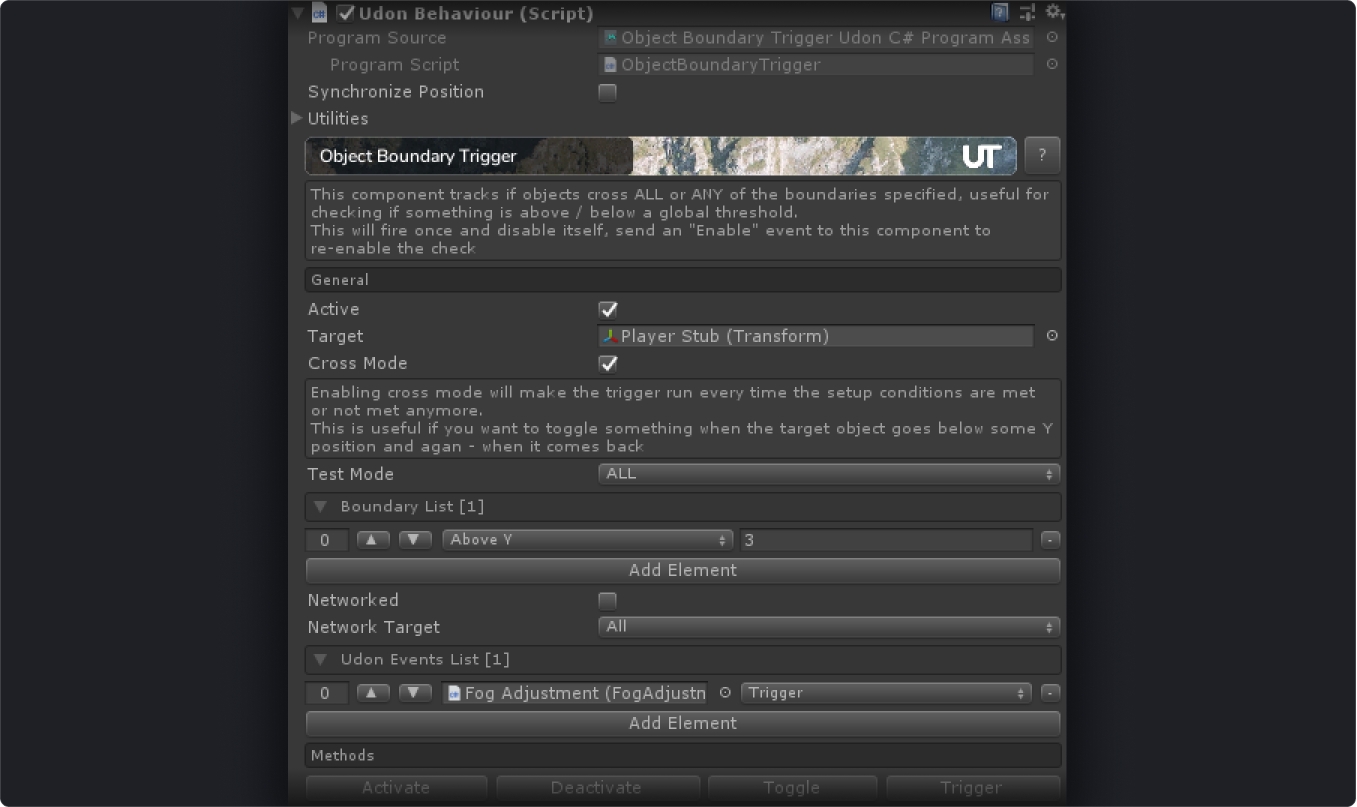
Parameters
Active: Toggles the threshold checks on and off
Target: The target object to observe
Cross Mode: Makes this trigger run every time the Target crosses the threshold (either way), also makes it, so the trigger doesn't disable itself after the threshold is crossed
Test Mode: Specifies whether the trigger will fire if ALL or ANY of the specifies boundaries are crossed
Boundary List: A list of conditions and coordinates to check against, e.g.
Above Y: 10will make the trigger fire events if the Target gets above 10 units on Y coordinateNetworked: Specifies whether the Udon Events should be sent to other players
Network Target: Specifies who to send the Udon Events to
Udon Events: A list of Udon Behaviours and Events to send
Events
Trigger: Fires the events specified in the Udon Events list
Activate: Activates the behaviour, so it will start checking the boundaries
Deactivate: Deactivates the behaviour, so it will no perform any checks
Toggle: Toggles the active state, provided for convenience
Usage / Examples
While this might seem confusing at first, the gist of this one is to trigger something when object's position exceeds one of the limits. A good example of it would be using a player head tracker and making it so if the tracker's Y position is below your water level in the map - you enable special fog settings or something like that.
By default, the trigger will only run once and disable itself, otherwise it will start triggering things every frame which is not perfect. You can enable it again by sending an Activate even to it.
Although often you might want to trigger things when the object crosses the limit in either direction. Like turning the fog on and off in the example above. In that case you would want to use the Cross Mode option that will trigger once every time the limits are crossed.
Platform Trigger
Sends Events to Udon Behaviours based on the User's Platform
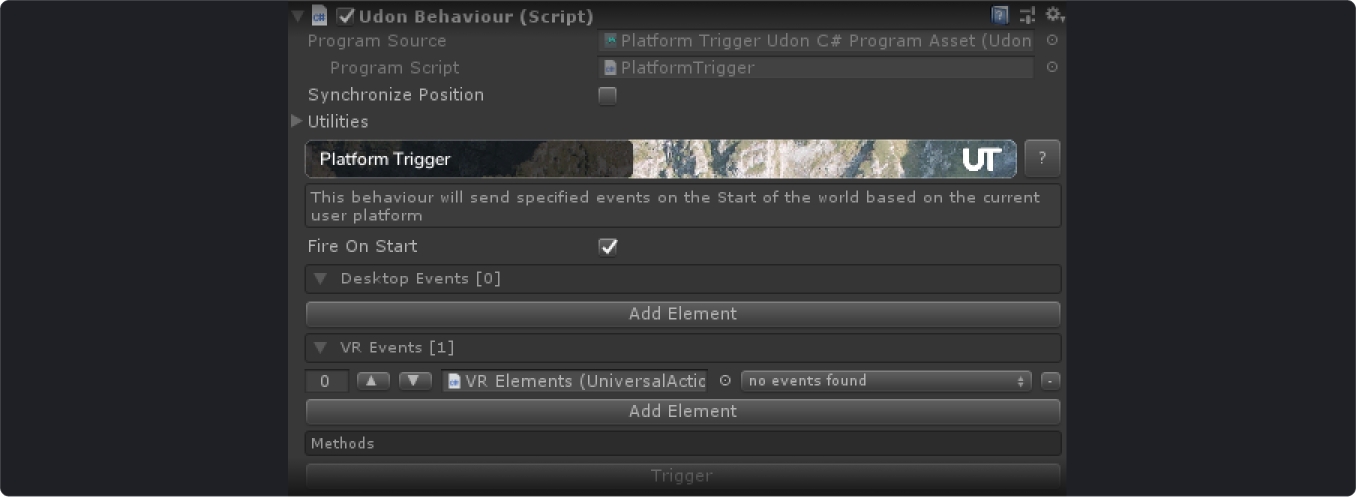
Parameters
Fire On Start: Specifies whether the events should be sent on start
Desktop Events: A list of Udon Behaviours and Events to send if the Player is on Desktop
VR Events: A list of Udon Behaviours and Events to send if the Player is in VR
Events
Trigger: Fires the events specified in the Desktop/VR Events Lists
Usage / Examples
By default this trigger will fire on the world load, unless the Fire On Start is unchecked.
Generally speaking this behaviours is aimed at providing better cross-platform support. Its pretty common to have separate versions of game mechanics, pickups, etc for different platforms that are enabled and disabled on Start.
You can also send the Trigger event to Platform Trigger to execute it again, e.g. if something happens in your world and you want Desktop / VR react to it differently.
Visuals
Skybox Adjustment
Switches skybox materials or smoothly adjusts values of a single skybox material
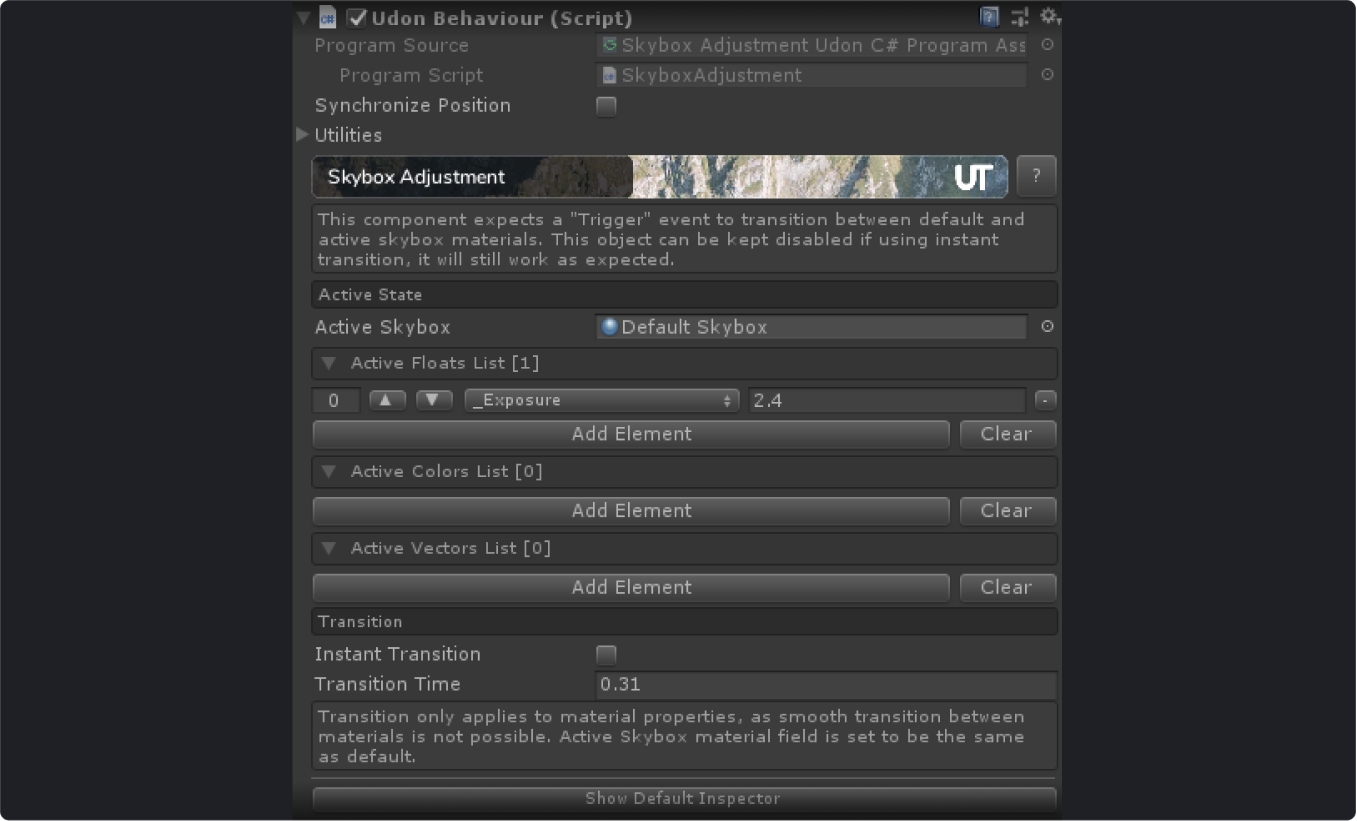
Parameters
Active Skybox: The skybox material to transition to
Active Floats List: A list of numeric parameters to transition to
Active Color List: A list of color parameters to transition to
Active Vector3 List: A list of Vector3 parameters to transition to
Instant Transition: Makes the skyboxes switch instantly
Transition Time: Defines the time, in seconds, over which the Float/Color/Vector3 values will be transitioned from default values to active and vice-versa
Events
Trigger: Performs a transition from default to active. Send it again to transition back
Usage / Examples
Main thing to decide on when using this is whether you need to transition instantly or slowly over time. If you want to transition instantly - its very simple
Select a material you want to swap the skybox to and put it into the
Active SkyboxfieldSend a
Triggerevent from one of the Udon Toolkit's many triggers when you want to switchDone
If you want to slowly transition between different settings, e.g. between high exposure and low exposure to imitate the day/night cycle - its a bit of a different setup
Uncheck the
Instant Transitioncheckbox and specify theLerp Timein secondsExpand the
Active Floats Listand clickAdd ElementChoose
_Exposurefrom the dropdown and set the value you want to transition to (e.g. 0.2)Send a
Triggerevent from one of the Udon Toolkit's triggers when you want to start transitioningDone
The Skybox Adjustment behaviour will use currently active values as a starting point (as of version v0.4.5)
Fog Adjustment
Switches between two different fog settings - instantly, or over time
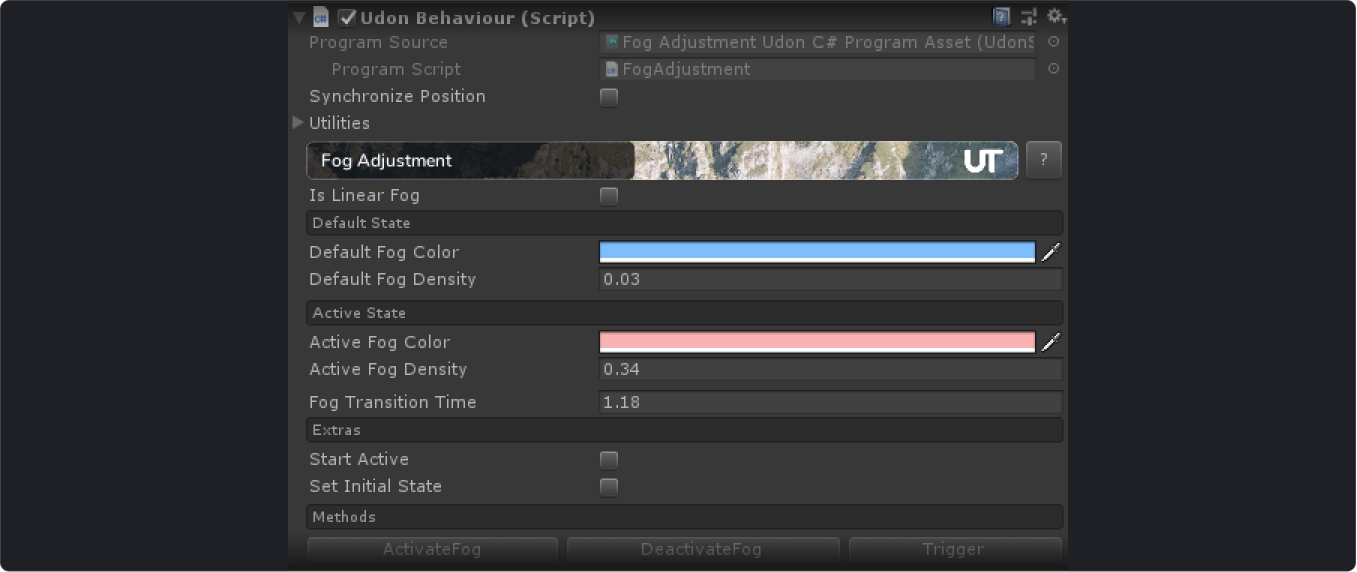
Parameters
Default Fog Color: First fog color to transition from
Default Fog Density: Only visible if the fog mode is not Linear. First fog density to transition from
Default Fog Start: Only visible if the fog mode is Linear. First fog start range to transition from
Default Fog End: Only visible if the fog mode is Linear. First fog end range to transition from
Active Fog Color: Second fog color to transition to
Active Fog Density: Only visible if the fog mode is not Linear. Second fog density to transition to
Active Fog Start: Only visible if the fog mode is Linear. Second fog start range to transition to
Active Fog End: Only visible if the fog mode is Linear. Second fog end range to transition to
Fog Transition Time: Specifies the duration of the transition, 0 to make it instant
Start Active: Makes it, so the fog will start from the active state, so the first transition will be Active to Default, instead of the other way around
Set Initial State: Applies the Default or Active fog settings, based on whether the
Start Activecheckbox is set
Events
ActivateFog: Explicitly transitions from Default to Active state
DeactivateFog: Explicitly transitions from Active to Default state
Trigger: Switches between the two states or starts a smooth transition
Usage / Examples
Very similar to Skybox Adjustment in terms of functionality.
Set the Default and Active setting and then use something like an Area Trigger to switch between them when a player enters or exits a particular area.
If you want to just slowly adjust from current values to the Active values - you don't have to set the Default settings at all. Those are only needed if you want to use 2 specific states and toggle between them.
Advanced
UI Readout
Takes compatible variable values from one Udon Behaviour and displays them in UI Text or UI Slider elements, with formatting support
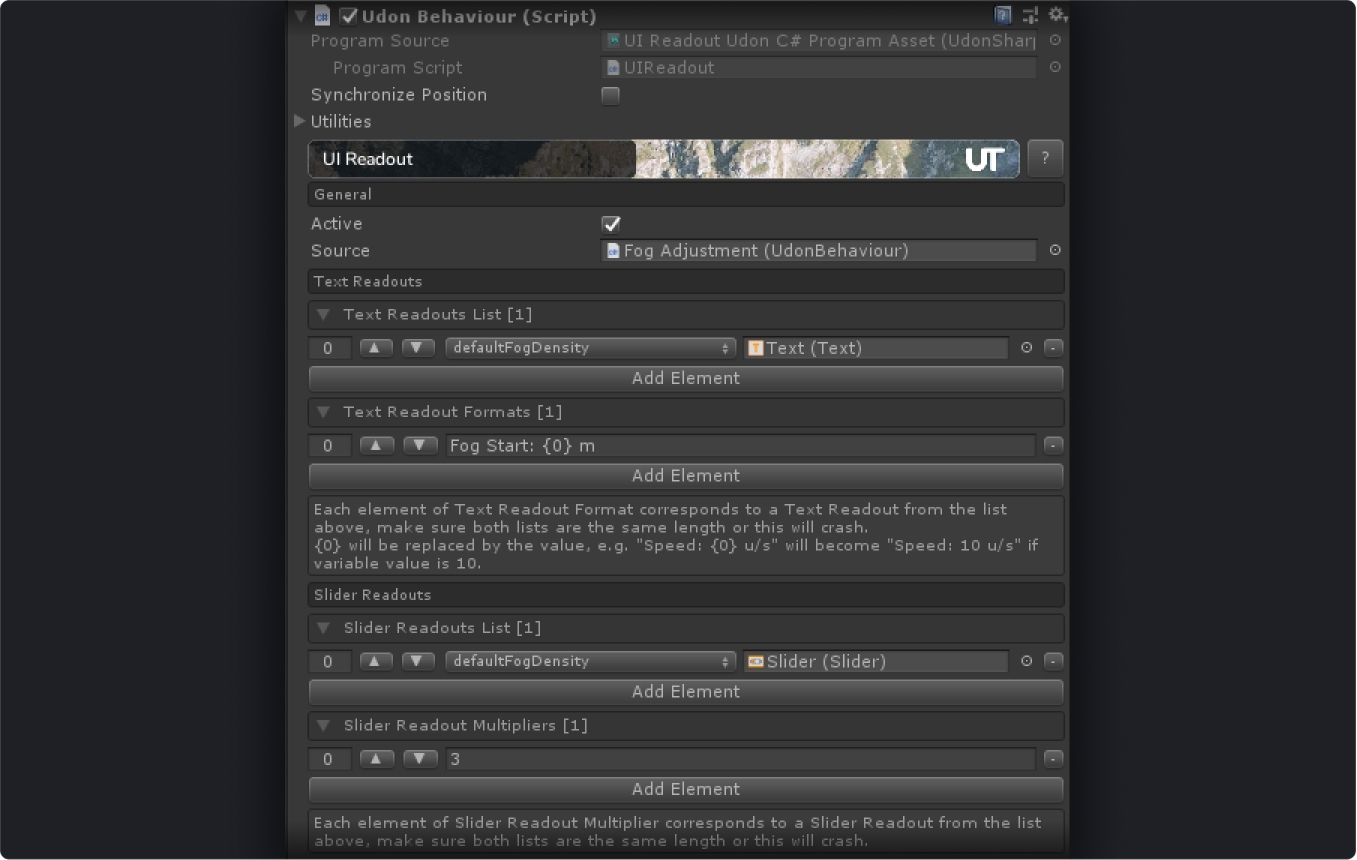
Parameters
Active: Turns the value update on and off
Source: The source of the values
Text Readouts List: A list of variables that can be converted to text and UI Text components to display them in
Text Readout Formats: A list of formatting rules applied to each readout value. It is very important to have the same amount of elements in both List and Format arrays. More on that below
Slider Readouts List: A list of numeric variables that can be assigned to a value of a UI Slider
Slider Readouts Multipliers: A list of multipliers that each variable value will be multiplied by, same rule as formats apply
Events
Activate: Activates the behaviour, so it will start reading fresh values
Deactivate: Deactivates the behaviour, so it stops reading values
Toggle: Toggles the active state, provided for convenience
Usage / Examples
The values are grabbed and assigned in
LateUpdateto have the most up to date values possible
Important: always make sure Formats and Multipliers lists have at last as many elements as Text Readouts and Slider Readouts lists respectively. The UI should generate the lists for you filled with default values, but it doesn't hurt to double check. Each row of the Formats / Multipliers list corresponds to the same row in the Text/Slider lists.
The formatter works by replacing {0} in whatever text you provide to each formatter with the value of the variable. So something like Speed: {0} u/s for a variable speed in the Target that has value of 10 will result in Speed: 10 u/s being displayed in the text element.
Multipliers work in a similar fashion - by multiplying a corresponding variable value by this multiplier before passing it to a slider.
UI Readout is built to provide a quick way of setting up something like a HUD you can attach to player's head via Unversal Tracker that would print out all the needed information from something like a flight system, or a combat system of some sorts. It will pre-populate lists of compatible variables for you, so you wouldn't need to dig into the code to figure out what you can display.
Note that this process can be performance heavy, so you don't want many of these behaviours running at all times, use the Toggle event to only read values when needed.
Shader Feeder
Passes various shader properties to a provided Mesh renderer
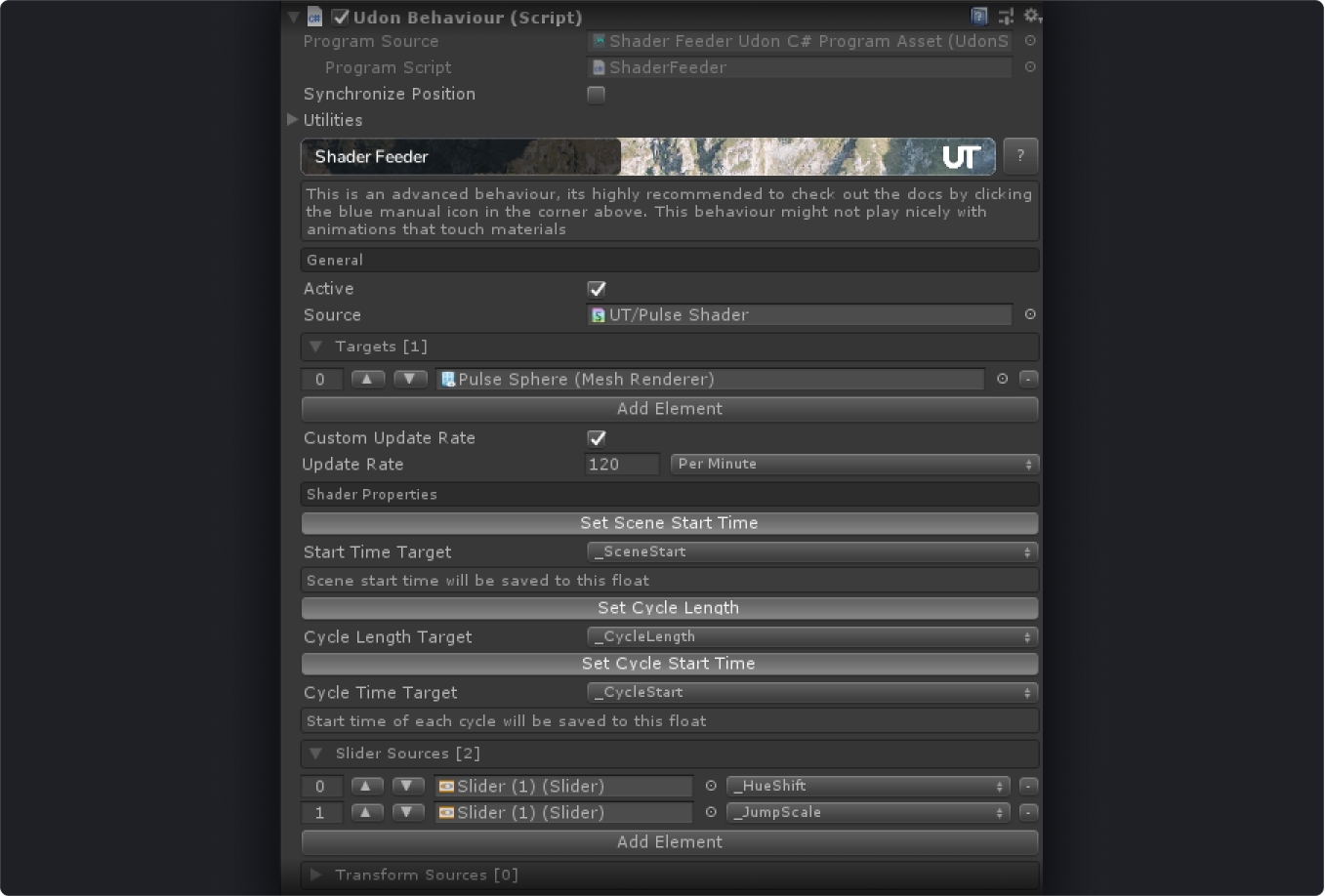
Parameters
Active: Turns the shader property value updates on and off
Source: The shader to get the property names from
Targets: The list of MeshRenderers to pass the property values to
Custom Update Rate: Specifies whether a custom Update Rate should be used, if unchecked - the values will be passed every frame
Update Rate: (Only visible if Custom Update Rate is checked) Specifies how often the values should be set, Per Second or Per Minute (think of it as BPM mode)
Set Scene Start Time: Specifies whether scene start time should be passed on world load
Start Time Target: Name of the property to pass the start time to
Set Cycle Length: (Only visible if Custom Update Rate is checked) Specifies whether the current cycle time (based on a Custom Update Rate) should be passed on Start
Cycle Length Target: Name of the property to pass the cycle length to
Set Cycle Start Time: Specifies whether the current time (which is also the time of the current update cycle start) should be passed
Cycle Time Target: Name of the property to pass the cycle start time to
Slider Sources: List of Slider components and corresponding property names to pass the Slider values to
Transform Sources: List of Transforms and corresponding property names to pass the Transform positions to
Usage / Examples
One of the most common examples would be to use ShaderFeeder as a way to pass some object's position to a shader. Player position being one of those, if used in combination with UniversalTracker in a Player Base Tracking mode.
To do that you will want to add a Transform that follows the Player to the Transform Sources list and choose a property to pass the value too and that's it!
Another popular choice would be to make an object do something on beat, in that case all you need is the Cycle Start Time and Cycle Length to be passed every Update Cycle. Check the Custom Update Rate and select Per Minute as the mode with your target BPM, and you're done!
The ShaderFeeder demo scene includes 2 basic shaders for things mentioned above: a Light Bridge of sorts that tracks a transform, and a BPM synced pulse with adjustable hue.
Last updated